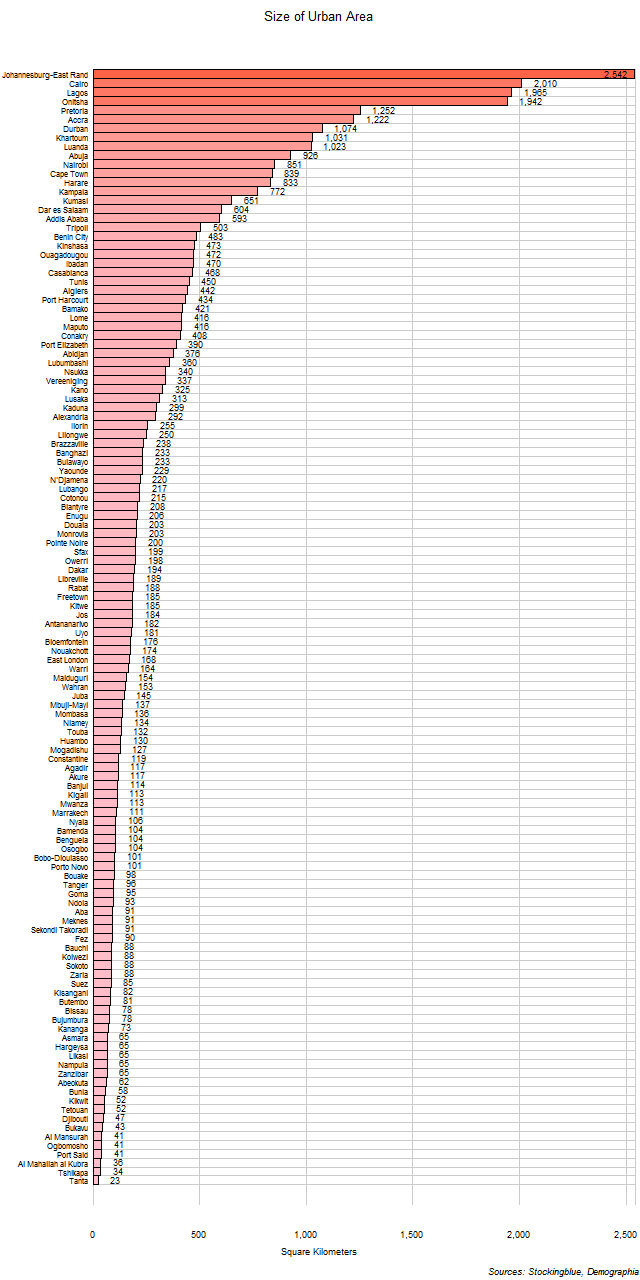
The chart above shows the urban area of each city with a population of over one million. The urban area has been normalized so as to avoid any inconsistencies with how cities and their metropolitan areas are defined by their governments. Each urban area has similar characteristics making this the definitive method with which to compare cities across various countries. South Africa has the largest urban area by size by far.
Findings
- The difference between the urban area with the greatest size, Johannesburg, and the urban area with the least, Tanta, is 2,519 square kilometers (972.59 square miles).
- Johannesburg has 110.52 times the urban area that Tanta does.
- The median size of urban area with a minimum population of one million in Africa is 181.50 square kilometers (70.08 square miles) and the mean 320.94 square kilometers (123.91 square miles).
Caveats
- Data is from 2020.
- The methodology for how these urban areas have been defined can be found in the source link below. As of this writing this is the most reliable way to compare urban areas throughout the world.
- Some of these urban areas span several states, and the state that is being used here is the one where the core of the urban area is located. For instance, Milan's urban area spans both Italy and Switzerland, but since the core of the urban area is in Italy it would be listed as an Italian urban area and not a Swiss one.
- All figures are rounded to the nearest whole.
Details
Only 43 of the 58 African states have urban areas with at least one million people. Of these, Nigeria has 24; the Democratic Republic of the Congo has 13; Morocco and South Africa each have eight; Egypt has seven; Angola has four; Algeria, Cameroon, Ghana, Tanzania, and Zambia each have three; Benin, Burkina Faso, Congo, Cote d'Ivoire, Kenya, Libya, Malawi, Mozambique, Senegal, Somalia, Sudan, Tunisia, and Zimbabwe each have two; and Burundi, Chad, Djibouti, Eritrea, Ethiopia, Gabon, Gambia, Guinea, Guinea-Bissau, Liberia, Madagascar, Mali, Mauritania, Niger, Rwanda, Sierra Leone, South Sudan, Togo, and Uganda each have one.
Johannesburg makes up one-twentieth of the total area of African urban areas with over one million inhabitants at 6.39%. It, along with Cairo make up one-tenth of the total area of African urban areas with over one million inhabitants at 11.44%. Adding in Lagos and Onitsha brings it up to over one-fifth at 21.26%.
Three of the nine urban areas with a population of over one million people that have an urban area of over 1,000 square kilometers are located in South Africa; Nigeria has two; and Angola, Egypt, Ghana, and Sudan each have one. Ten of the 35 urban areas with a population of over one million people that have an area less than 100 square kilometers are located in the Democratic Republic of the Congo; Nigeria has six; Egypt has five; Morocco has four; and Burundi, Cote d'Ivoire, Djibouti, Eritrea, Ghana, Guinea-Bissau, Mozambique, Somalia, Tanzania, and Zambia each have one.
Nigeria has the largest area covered by its urban areas of over one million people with a total of 3,555 square kilometers (1,372.59 square miles) distributed among its 24 urban areas. South Africa has the second largest area covered by its urban areas of over one million people with a total of 2,617 square kilometers (1,010.43 square miles) distributed among its 108 urban areas.
Botswana, Cape Verde, the Central African Republic, Comoros, Equatorial Guinea, Lesotho, Mauritius, Mayotte, Namibia, Reunion, Saint Helena, Ascension and Tristan da Cunha, Sao Tome and Principe, Seychelles, Swaziland, and Western Sahara do not have any urban areas with a population of over one million inhabitants.
Sources
Demographia. 2021. "Demographia World Urban Areas: 16th Annual Edition." Accessed March 9, 2021. http://demographia.com/db-worldua.pdf.